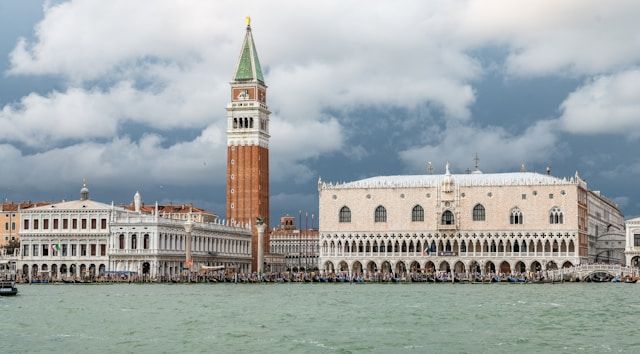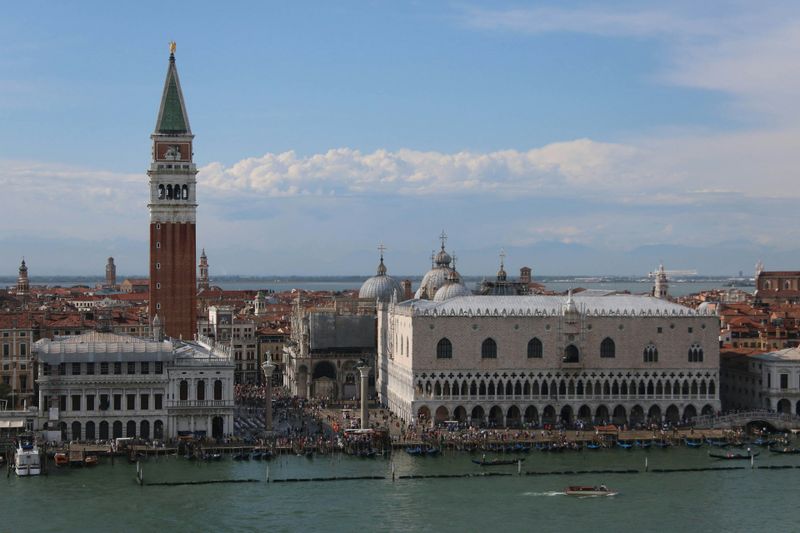Venice, the "Floating City," is renowned for its enchanting canals, romantic gondolas, and intricate labyrinth of narrow streets.
But as one explores this captivating city, a question often arises: Why are the streets of Venice called calli?
This question leads us to uncover a unique aspect of Venetian culture and history, deeply intertwined with its distinct geography and development over centuries.
Why are the streets of Venice called Calli: The word derives from the Latin "Callis"

The term "calle" is derived from the Latin word "callis," meaning "path" or "track." This linguistic root is significant, as it reflects the original function of these streets as narrow pathways through cultivated fields or between buildings in ancient Venice. Over time, these paths evolved into the intricate network of streets that now characterize the city.
Calle Turlona in Venice
Venice’s streets, known as "calli" (plural for "calle"), are a distinctive feature of the city, with names that echo the past and reflect the city’s historical and cultural richness.
For example, Calle Turlona, like many others, weaves through the dense fabric of buildings, offering glimpses of the city's storied past.
Calle del Forno, Calle Larga, Calle della Madonna, Calle Varisco
Venetian streets are more than mere passages between buildings; they are markers of history. Some streets are named after the activities once conducted there, like Calle del Forno (Street of the Oven), Calle Larga (Wide Street), or Calle della Madonna (Street of the Madonna).
Others, like Calle Varisco, are known for their peculiar characteristics—Calle Varisco is famously one of the narrowest streets in Venice, barely 53 centimeters wide at its narrowest point.
Not all Calli are alike: Some are larger (the "Calli larghe") and some narrower
Venetian streets are not uniform; they vary significantly in width and purpose. The broader streets are known as Calli Larghe, like Calle Larga in San Marco, while the narrower ones retain the simple name "calle."
Some calli end in a dead end, referred to as "rami," meaning "branches," which further emphasizes the organic, tree-like structure of the city's street network. This diversity in street size and form adds to the charm and complexity of navigating Venice.
Why are streets in Venice called calle?
The streets of Venice are called calli because of the city's historical development, where small paths gradually evolved into streets. The name "calle" has persisted over centuries, rooted in the city's need to distinguish its unique streets from those found in other Italian cities.
The usage of "calle" instead of "via" (the more common Italian word for street) underscores Venice's distinct identity, shaped by its isolation from the mainland and its dependence on a complex network of canals and narrow streets for navigation.
Venice's streets are more than just functional spaces; they are an integral part of the city's identity. The term "calle" encapsulates not just the physical characteristics of these streets but also their historical and cultural significance.
In Venice, each calle tells a story, often reflecting the activities, people, or landmarks associated with that particular street.
What does Calli mean in Venice, Italy?
In Venice, "calli" refers to the narrow streets or alleyways that crisscross the city, connecting its numerous canals, bridges, and small squares known as "campi." The word "calle" emphasizes the narrowness and intimacy of these streets, many of which are pedestrian-only due to their size and the city's car-free environment.
Calli vary in width and length, but they are typically much narrower than the streets found in other Italian cities, further contributing to the unique charm of Venetian toponymy.
The calli are more than just routes for getting from one place to another; they are the veins through which the lifeblood of the city flows. Venetian streets often lead to unexpected discoveries, whether it’s a hidden campo, a secluded canal, or a historic building that’s been standing for centuries.
What is the Calli of Venice?
The calli of Venice are a vital part of the city's architectural and urban fabric. They are often flanked by tall, narrow buildings made of Istrian stone or brick, with white stones marking the edges of the streets.
These streets create a maze-like structure that has fascinated and sometimes bewildered visitors for centuries. The calli are also home to some of the most famous Venetian landmarks, such as the Grand Canal, Piazza San Marco, and the Rialto Bridge.
The Venetian Republic meticulously organized and named these streets, with each calle serving a specific function within the city's economy and daily life.
Some calli were named after trades or professions, like Calle del Forno or Calle del Tagiapiera (Street of the Stonecutter), while others took their names from religious symbols, noble families, or geographical features.
What are the sections of Venice called?
Venice is divided into six main districts, known as "sestieri." Each sestiere contains a complex web of calli, campi, canals, and bridges. The sestieri are San Marco, San Polo, Cannaregio, Castello, Santa Croce, and Dorsoduro. Each of these areas has its own unique character and history, reflected in the names of its streets.
For instance, in the Cannaregio district, one might find Calle Larga or Calle Benzoni, streets that speak to the neighborhood's history and development. San Polo, home to the Rialto area, is crisscrossed with narrow calli like Calle del Cristo and Calle del Paradiso.
In Dorsoduro, near the Giudecca Canal, you'll encounter Calle Vallaresso and Calle Dolfin, streets named after notable Venetian families.
The most famous Calli of Venice
Venice is home to some iconic streets that are well-known both for their historical significance and their modern-day charm. Here are a few of the most famous calli:
- Calle del Forno: Located in the Cannaregio district, this calle is named after an ancient oven that once stood here, a reminder of the area’s bustling trade and daily life.
- Calle della Madonna: Situated near San Marco, this calle is named after a Madonna statue that once adorned one of the street’s corners, a common feature in Venetian streets.
- Grand Canal: While technically not a calle, the Grand Canal is Venice’s most important waterway, around which many significant calli are located, including Calle Vallaresso.
- Calle da Ponte: This calle is named after one of the many bridges that connect Venice’s streets across its canals. The name highlights the importance of bridges in the city’s layout.
- Calle Varisco: Known as the narrowest calle in Venice, Calle Varisco in Cannaregio is a must-see for visitors intrigued by the city’s unique urban design.
Why are the streets of Venice called Calli: The rich tapestry of venetian streets
Venice is a city that thrives on its history, culture, and unique geography. The term "calle" is more than just a word; it is a key to understanding how this city was built and how it continues to function.
Each calle, from the Calle del Forno to the Calle della Madonna, from the Grand Canal to the Calle da Ponte, tells a story that connects ancient Venice with the present.
In the maze of Venice's calli, you can find the soul of the city. Streets like Calle Varisco, Calle del Tagiapiera, and Calle Dolfin carry the weight of centuries of history, from the days of the Venetian Republic to modern times.
As you walk these Venetian streets, from Campo San Polo to Piazza San Marco, you are treading on paths that have been shaped by time, culture, and the natural elements of the lagoon.
Whether you’re exploring Cannaregio or getting lost near the Rialto Bridge, the calli of Venice offer a unique glimpse into a world where history, architecture, and everyday life intersect in fascinating ways.
Understanding why the streets of Venice are called calli adds a new layer to appreciating this extraordinary city, where every narrow street, canal, and bridge has its own story to tell.

